Mian -Yu-Ting Cemetery,Johor (Part 1)
2by Choo Ai Loon
The Mian-Yu-Ting Cemetery (绵裕亭) across the causeway in Johor, Malaysia, has an area of about 60 acres. The cemetery which has been closed for burial includes a casket company, a crematorium and two columbaria, among other facilities.
I attended a tour of the cemetery led by Mr Bak Jia How and Mr Pek Wee-Chuen who are alumni of Foon Yew High School in Johor. The tour was to commemorate the 100th anniversary of the school, and dedicated to two of the four founders who were laid to rest in Mian-Yu-Ting.
We also visited the graves of other contributors to Foon Yew and stories about them were shared. At the same time, I learned other interesting facts about the graves, in particular, the meaning behind the unique inscriptions .
The land for the cemetery was a gift by Sultan Abu Bakar in 1885. In the 1920s, due to poor management, burials had mistakenly crossed over onto an adjacent piece of land. That land was owned by a tycoon, Al-Habib Hasan bin Ahmad al-Attas of Arab origin, but born in Malaya. He however kindly agreed to donate a part of the land to the cemetery. As a token of gratitude, a Rosetta stone was erected within the compound to remember his generosity.
The Chinese character “氵月” on the tombstone circled below means ‘Qing (Dynasty) without a leader’ (清无主). This was a secret word created to symbolise the movement to overthrow the Qing Dynasty (1644-1912) and to revive the Ming Dynasty (1368-1644).
However, engraving the character on a tombstone in Nanyang (Southern Seas or south of China) in the last 200 years did not necessarily mean one was active in the movement. It can be interpreted to symbolise the unity among members from a certain cohort or gang, formed by early Chinese migrants to Nanyang.; in this instance, the Teochew community.
Notably, most of the tombs in Mian-Yu-Ting that carry “氵月” character are on Teochew tombs and not found on the Cantonese tombstones there . Have you seen the same character at any tomb in Bukit Brown?
There is tomb adorned with Majolica tiles which was built when the Ngee Heng Kongsi was ordered to dissolve in 1919. The Ngee Heng Kongsi was a powerful Teochew gang in Johor and an offshoot of the Tian-Di-Hui (天地会) secret society in China. The society aimed to topple the Qing Dynasty so as to reinstate the Ming Dynasty.
That said, the overseas offshoot of Ngee Heng Kongsi was largely committed to taking care of the welfare of early Chinese immigrants. When it wound up, a fraction of its funds was spent on building this tomb, with the Chinese words of Ming-Mu (明墓), meaning Ming tomb, engraved on the headstone.
The remaining fund, a substantial sum at that time, was donated to Foon Yew School. And in return, the school would have to perform rituals at the tomb twice a year, on the 3rd day of the third Lunar month (spring) and the 25th day of the seventh Lunar month (autumn). For almost a century now, the school continues to fulfil its promise.
No one was buried under the tomb. Instead, a catacomb was said to have been built to place ancestral tablets of important members of the gang, and to safe keep sacred objects. Notably, Ngee Heng Kongsi had established one of the earliest Chinese settlements in Johor. We certainly won’t be where we are today without our pioneers.
Here are some highlights from other graves
At one grave, there is a larger-than-usual placement of the Guardian Deity of Earth which is comparable to the one at Ong Sam Leong’s in Bukit Brown.
In Singapore and Malaysia, the Guardian Deity of Earth may be addressed in Mandarin as Tu-Di-Zhi-Shen (土地之神), just like the one in the photo, or Hou-Tu (后土) or Fu-Shen (福神). Have you seen another name being used in Bukit Brown?
A mythical creature Ao-Yu (鳌鱼) has a dragon’s head and a fish’s body, it is believed to have transformed from a carp.
I hope these discoveries may lead you to exclaim “oh I see!”; or trigger a memory: “oh I have seen this somewhere before!”.
I would like to thank Pek Wee-Chuen and Bak Jia How, for an enjoyable tour and sharing their knowledge with me.
Look for part 2 of my journal on Mian-Yu-Ting. Highlights include, a Johorean connected to a high school in Singapore and, the story of a family business which parallels that of Teochew leader, Seah Eu Chin.
Choo Ai Loon, works as a translator and is passionate about art and heritage, She supports Hair for Hope for children with cancer.
She blogs at http://chooailoon.wordpress.com/2013/05/05/hair-for-hope-2013/
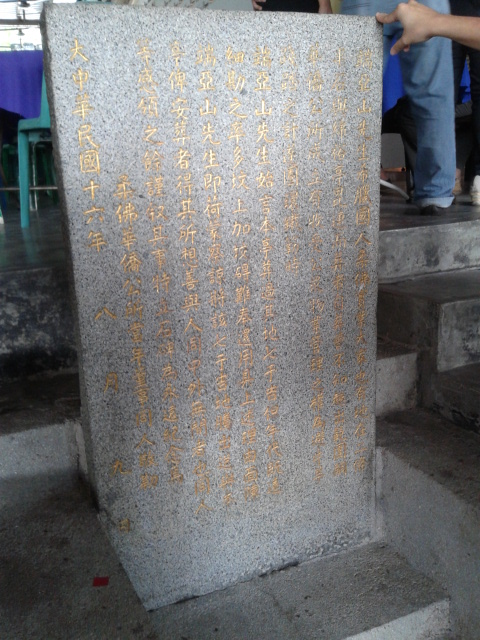
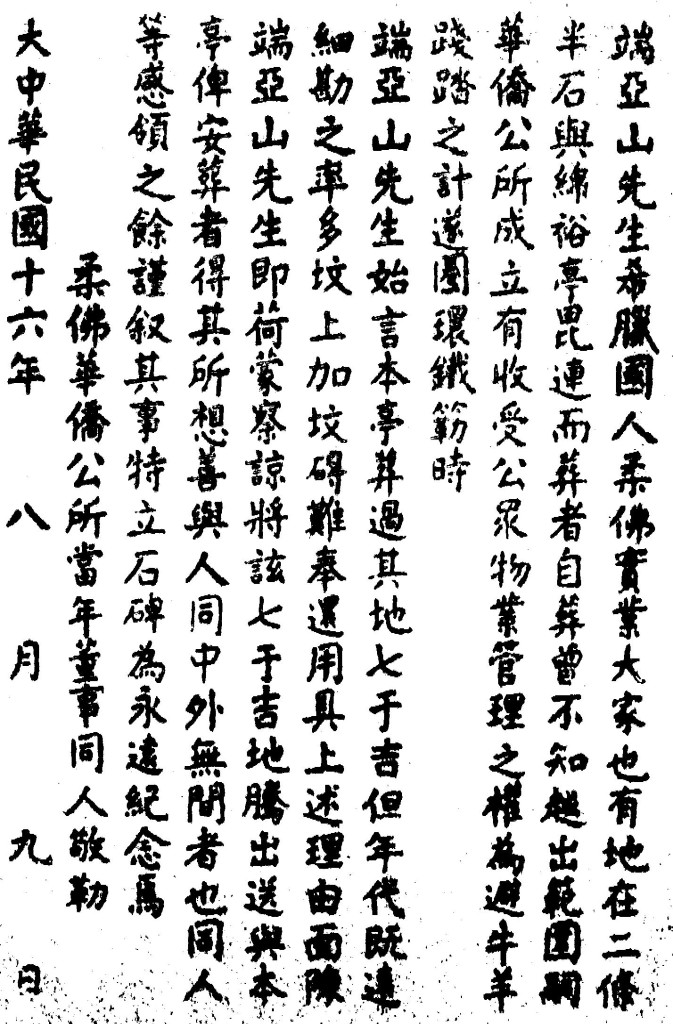
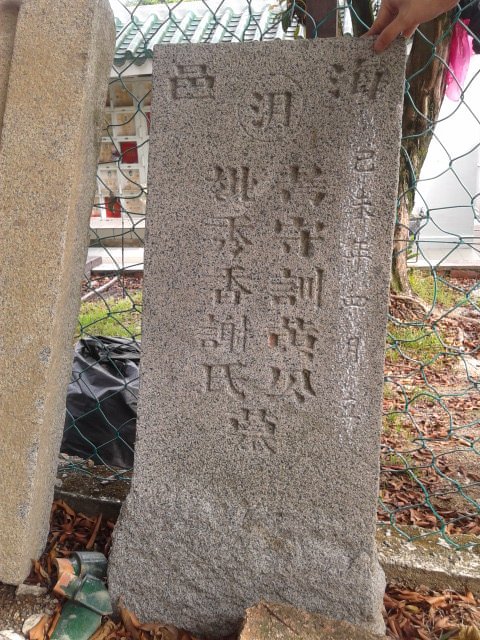
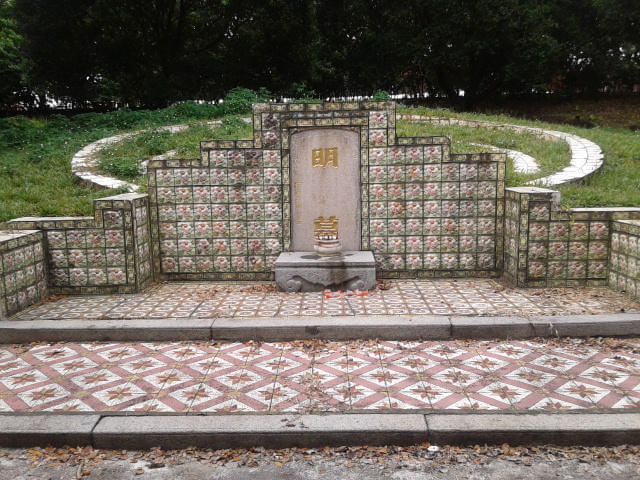



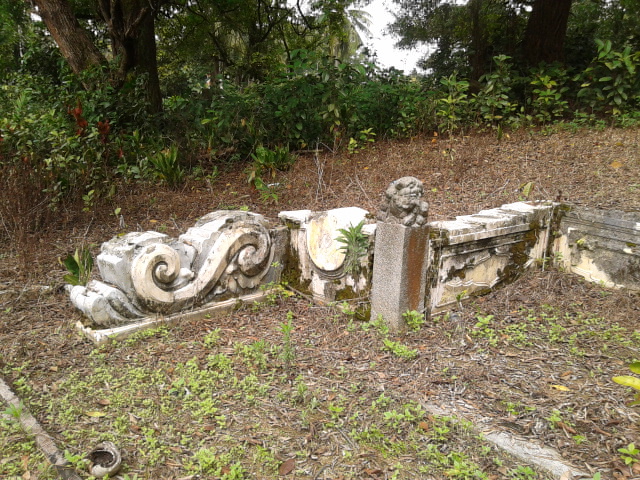
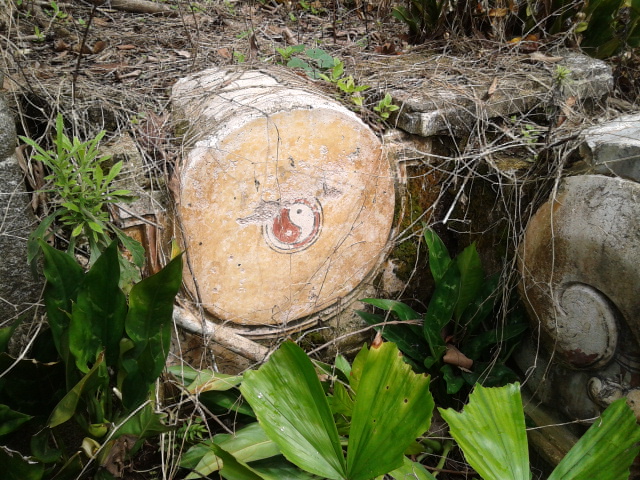
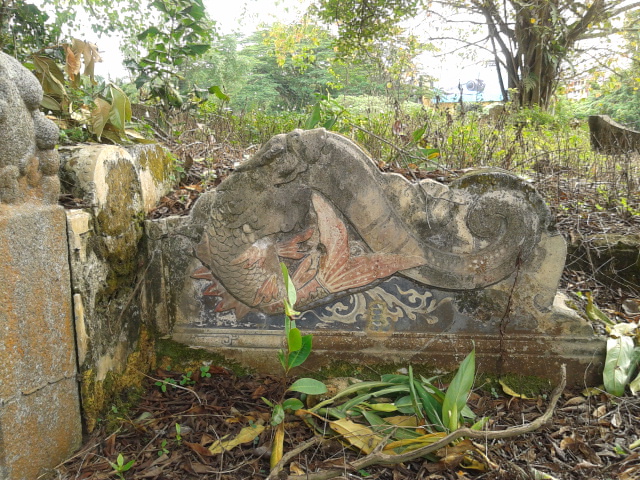

From post: “In Singapore and Malaysia, the Guardian Deity of Earth may be addressed in Mandarin as Tu-Di-Zhi-Shen (土地之神), just like the one in the photo, or Hou-Tu (后土) or Fu-Shen (福神). Have you seen another name being used in Bukit Brown?”
Elsewhere in S’pore … On the Outram Road hill cemetry, there are no Earth deity altars but instead 2 nos. 山靈 (shān líng) altars — at Tan Tock Seng’s tomb (photo) & the double-tomb of his daughter-in-law + granddaughter-in-law (photo) respectively.
* Graves of Tan Tock Seng, his Daughter-in-Law and Granddaughter-in-Law @ Outram (Entree Kibbles – 21 Aug 2013)
In Taoist ideology, every mountain has a guardian dragon, & 山靈 refers to Dragon Mountain Spirit. For tombs that have altars dedicated to both the Earth deity & the Dragon Mountain Spirit, the order of worship is thus: Earth deity, Dragon Mountain Spirit, followed by the tomb of the deceased.
* 山靈 (龙神) (Encyclopedia of Taiwan – 09 Sep 1998)
On a related note, for tombs that faithfully adhere to Chinese geomancy/ constellation principles, the mythological Azure Dragon is placed on the east (representing spring & renewal), while the mythic White Tiger are placed on the west (representing autumn & decline).
Oon Chim Neo’s large tomb at Seh Ong Cemetery (Kheam Hock Road) is a good illustration of Chinese geomancy at work. The stone mound (immediately behind the tombstone) resembles a tortoise’s carapace that represents the heavenly dome, as well as the mythic Black Tortoise of the North — which in turn symbolizes winter & death. The tomb is guarded by a dragon’s claw on the right (east), as well as a tiger’s paw & the Earth’s deity on the left (west). At this tomb, the 4 cardinal directions are not metaphorical but actual & exact — one can verify this with a compass. For instance, the tomb mound (tortoise carapace) is located at the geographical north.
Back to the Earth deity … At Ying Fo Fui Kua (the Hakka clan cemetery near Commonwealth MRT station), there are 2 communal Earth deity altars labelled as 嘉应五属后土 (jiā yīng wǔ shǔ hòu tǔ) (photo) & 嘉应五属福神位” (jiā yīng wǔ shǔ fú shén wèi) (photo).
* Ying Fo Fui Kun Cemetery at Holland Village (Entree Kibbles – 02 Sep 2012)
* Backyard Cemetery (itchyfingers – 11 Sep 2012)
Curiously, why does a clan cemetery label its communal Earth deity with 2 names ? Apparently, this helps cover the bases. According to this post (SG Forums – 30 Apr 2013), it seems that 福神 protects the business professionals, while 后土 protects the rest of the population.
In Taoist culture, other synonyms for the Earth deity (besides 土地之神, 福神 & 后土) include:-
* 土地公 (tǔ dì gōng) — Earth Uncle
* 土治公 (tǔ zhì gōng) — Land Governance Uncle
* 伯公 (bó gōng) — Old Uncle Earth
* 社神 (shè shén) — Community God
* 社公 (shè gōng) — Community Uncle
* 福德正神 (fú dé zhèng shén) — Blessed, Moral & Just God
The following essays provide more details:-
* 福德正神 (Earth God) (Encyclopedia of Taiwan – 10 Nov 1998) — English version
* 华夏诸神: 福德正神、土地公、后土、社神、社公、伯公 (12 Zodiac Network – 27 Jul 2012)
* 福德正神-伯公 (Chu-Tung Chung-Shan Elementary School – 2008)
Interestingly, ever since the originally-male 后土 god gained its feminine duality due to the influence of ying-yang philosophy during the Tang Dynasty, 后土 is also known by the following feminine monikers:-
* 后土娘娘 (hòu tǔ niáng niàng) — Earth Goddess
* 后土夫人 (hòu tǔ fū rén) — Lady Earth
* 地母娘娘 (dì mǔ niáng niàng) — Earth Mother Goddess
* 地母娘娘 (Encyclopedia of Taiwan – 09 Sep 1998)
Hi Ms. Choo:
Where is the Ming tomb located with the Mian-Yu-Ting Cemetery/JB?
My maternal grand-father is buried in this cemetery, and I have never heard of, or seen the Ming tomb mentioned in this story.
Many thanks,
Mark